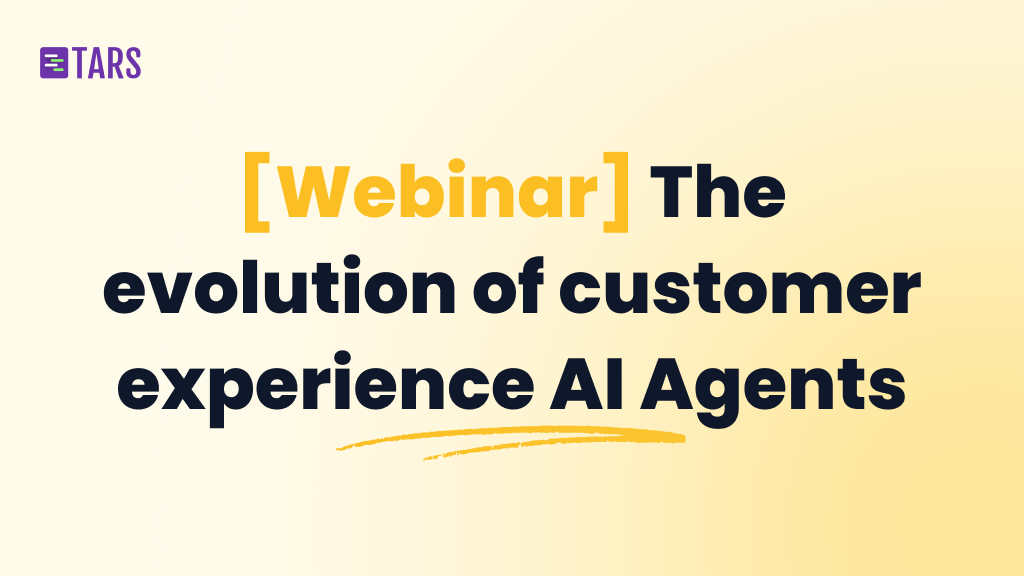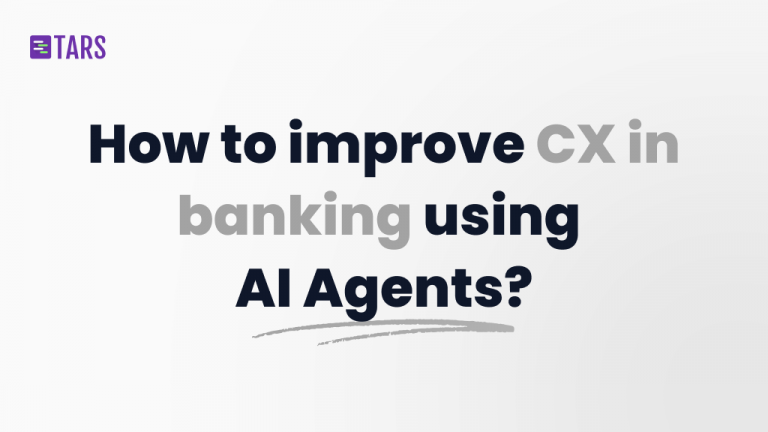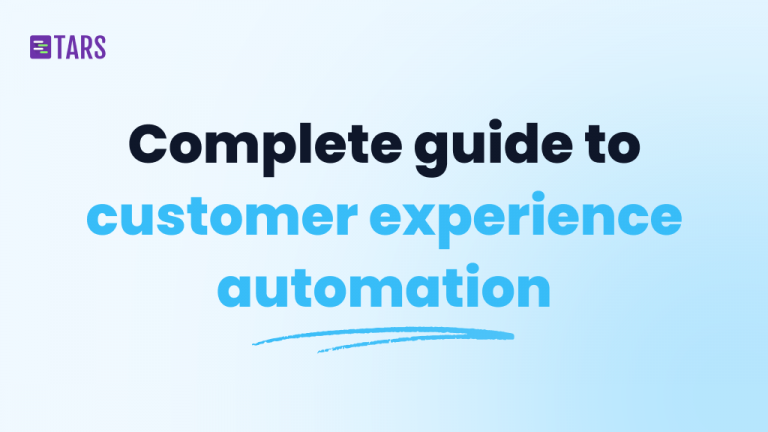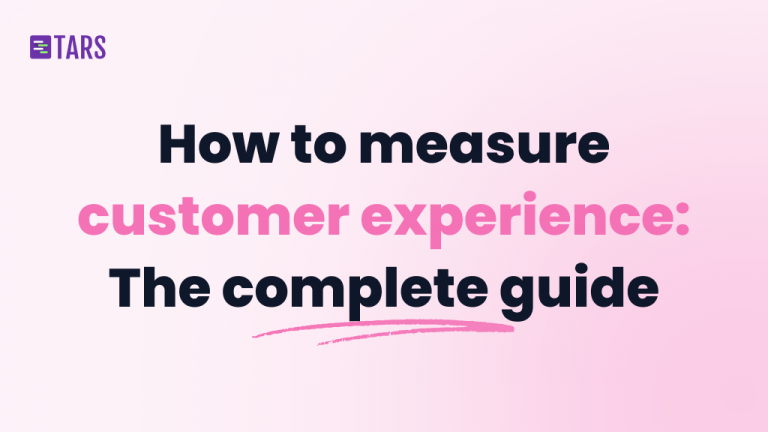[Webinar] The evolution of customer experience AI: From rigid chatbots to intelligent AI

Why customer experience AI matters now
If you run a business, you already know that getting new customers and keeping existing ones are the most important things. That hasn’t changed. What has changed is how we deliver customer experiences with AI.
Our CTO, Vinit, has spent almost ten years building customer experience AI platforms at Tars. Here’s what we’ve learned about CX AI Agents, what they are, why they matter, and how the technology has evolved from basic chatbots to something much better.
This blog is based on Vinit’s recent webinar. Dive in!
What is customer experience AI?
Customer experience AI refers to AI-powered systems that handle customer interactions across their entire journey. It covers everything your business does when interacting with customers throughout the entire lifecycle.
Every business has customers moving through stages. There’s the pre-sales stage where people are checking out your product, asking questions, trying to figure out if you’re what they need. Maybe they found your website, landed on your WhatsApp, or came through your social channels. They’re curious, gathering information, seeing if what you offer matches what they’re looking for.
Then there’s the post-sales stage, where actual customers need support, have issues, and want answers. They’re already using your product or service. They have questions about how something works, they run into problems that need solving, and they need help with specific features.
CX AI Agents are basically your company in conversational form. They represent your business, answer questions, do things for customers, and they’re always available. Think of them as your sales and support team, but they scale infinitely and stay consistent. Traditional businesses have always had salespeople to help prospects and support teams to help customers. Customer experience AI is taking on some of that work in a scalable way.
Two main use cases for
- Customer acquisition, lead generation, used by marketing and sales teams
- Customer support, customer retention, is used by support teams
Most people think customer experience AI is just for support. But there’s a huge opportunity in lead generation that not many companies explore. You can build an Agent specifically to market a new product, run upsell campaigns to existing customers, or capture qualified leads from your website traffic.
What makes a good customer experience AI?
The main goal is simple: give users a really great experience.
This sounds obvious, but it’s actually the key to everything. If users have a great experience with your support structure, even if they’re not ready to buy right now, they’ll remember you. They’ll come back. And all your business metrics, conversion rates, resolution rates, retention, follow naturally.
Good experience means answering questions well and reliably, actually doing things for users like booking appointments, collecting info, creating tickets, updating CRMs, and representing your brand accurately and consistently.
At a technical level, CX AI Agents need to do two things really well: answer user questions in a reliable way, and take actions on the user’s behalf. Those two capabilities drive the business metrics that matter, conversion rate for pre-sales and resolution rate for post-sales.
Who uses customer experience AI?
Pretty much any business with customers can benefit from customer experience AI. But the need really depends on scale. If you have just one customer, you can probably just talk to them directly. But if you have thousands or millions of customers, you need scalable AI to deliver consistent experiences.
At Tars, we’ve focused on B2C businesses with large customer bases. We’ve worked extensively with financial institutions and banks, healthcare companies, government agencies, education institutes, and telecom companies.
These industries all have huge customer bases, lots of repetitive questions, but also plenty of nuanced queries. They have complex use cases where customers need to actually get things done. Delivering these experiences manually is expensive and inconsistent; it depends heavily on which support person or salesperson someone talks to. Customer experience AI solves this problem.
How did traditional customer experience automation work?
For the past decade, we built what we’ll call traditional customer experience AI at Tars 1.0. You’ve definitely seen these, the widget on websites that pops up and guides you through pre-set conversation paths with buttons.
The old system
These were rule-based systems with predefined, rigid conversation flows, mostly button navigation where users clicked options, limited or no text input (we often disabled the text field completely because we knew it couldn’t handle open-ended input), simple keyword matching for basic queries, and linear paths you had to follow exactly.
At the time, this experience was better than filling out boring web forms or waiting for slow live chat responses. The interface was more interactive than a form, which people tend to abandon quickly. Even though people knew they were talking to a bot, not a person, the experience felt slightly more engaging.
What traditional customer experience AI looked like
Here’s a real example from a real estate customer experience AI Agent we built:
The Agent would ask for your name.
Then it would show you buttons: “I want to buy,” “I want to sell,” “I want to rent.” You click one. Then, more buttons for property type. More buttons for location. More buttons for budget range. At each step, you’re clicking through a predetermined path. You can’t just type “I’m looking for a 3-bedroom apartment in downtown under $2000.” You have to click through maybe 10-15 screens to communicate that same information.
It was basically a replacement for a web form, but dressed up as a conversation.
The problems with old customer experience AI
For users: Really restrictive conversations where you couldn’t deviate from the script, couldn’t ask open-ended questions mid-flow, people abandoned them a lot because it felt tedious, a pretty frustrating experience overall, and very limited scope of what the customer experience AI could actually help with.
For builders: Incredibly complex to build, even for simple use cases. Needed 60-70 connected workflow nodes for even basic Agents. Any real-world customer experience AI use case needed our CS team to be heavily involved. Each FAQ needed its own separate flow built out. Authentication and tool calling required extensive manual setup. Painful to update or change anything once built.
For maintenance: Had to manually find and fix problems by analyzing drop-off points, constant tweaking and experimentation needed, lots of ongoing work just to keep the customer experience AI running smoothly, and very tedious optimization process.
Even a simple chatbot requires building this massive web of interconnected nodes with complex logic connecting them. We have screenshots of our old builder; it looks like a tangled mess of boxes and arrows.
The new way: LLM-based AI Agents
What we’re building now at Tars 2.0 is completely different. We’re solving the same problem, delivering good customer experiences, but using LLM-based AI Agents. This is a real paradigm shift. It’s not just an incremental improvement; it’s a fundamental technology change in customer experience AI.
We launched Tars 2.0 in June this year and have been deploying this new customer experience AI for customers across different industries.
What users see with modern customer experience AI
Old customer experience: Click button: “I want information,” Click button: “New cars,” Click button: “SUVs,” Click button: Select price range, Click button: Select features, Enter name in field, Enter email in field (with validation), Enter phone in field, Click submit, Wait for response.
New customer experience:
- User types: “I want to buy a car”
- Agent: “What kind of car are you interested in?”
- User: “Looking at the [model name]. Can I test drive it? I’m John Smith, john@email.com, 555-1234″
- Agent: Extracts all information from that one message, books an appointment immediately, and confirms details
The conversation feels natural. Users can type whatever they want, use voice input to speak their requirements, and give multiple pieces of info at once. The customer experience AI Agent understands what they mean and what they want. It knows that when someone asks for a test drive, it needs to collect their name, email, and phone number, and it can extract all of that from a single user message instead of asking for each field separately.
It’s like talking to a person, but faster. And unlike a person, the customer experience AI Agent can book appointments instantly, fetch car specifications from the database in milliseconds, and check availability without putting you on hold.
What builders see with modern automation flows
Remember those 60-70 workflow nodes? Now, AI Agents function with just 3 primary components:
- AI Agent gambit: The LLM brain that does the heavy lifting, understands intent, and manages the conversation
- Knowledge gambit: Your website, documents, FAQs (automatically scraped and indexed)
- Tools: Connections to your apps and systems (we have 600+ apps available with multiple tools each)
That’s it. You write a prompt that defines how the AI Agent should behave, connect your website or upload documents (the system automatically creates a knowledge base), add your tools by connecting your apps, and you’re done.
For the Knowledge Base, you literally just paste your website URL or upload your documents. The AI system scrapes everything and makes it searchable for the Agent. No manual FAQ building, no creating separate flows for each question.
For tools, we have integrations with over 700 tools. Each app has multiple sub-tools inside it. Active Campaign has 21 different tools. Airtable has 17 tools (create row, update row, create table, etc.). Google Sheets, Google Calendar, HubSpot, Salesforce, Zendesk, all available.
You just connect the app, and the AI Agent figures out which specific tool to use based on the conversation context. Earlier, you’d have to configure each API endpoint manually, map the request data, and handle the response. Now it’s automatic.
Here’s what happens in the process:
- User asks a question or makes a request
- The LLM brain understands what they want and analyzes their intent
- It decides if it needs to look up information from the knowledge base or use a tool
- It retrieves relevant information or executes the needed tool
- It generates a response based on all the context
- If needed, it loops back and uses more tools or retrieves more information
Why LLM-based AI Agents are better?
The difference is significant across every dimension of customer experience automation.
For users: Natural, free-flowing conversations that adapt to their intent. Can ask anything; the customer experience AI scope is essentially unlimited if it’s in your knowledge base. Gets context and nuance (understands “I’m looking for something cheap” vs “I’m looking for budget-friendly options”). Fast, accurate answers pulled from your actual documentation. Can complete complicated tasks quickly without multiple back-and-forths. Can provide information in multiple ways (text, voice, buttons for quick actions).
For builders: Way faster to set up, which requires days instead of months. Easier to maintain, update your knowledge base, or adjust your prompt instead of rewiring workflows. Can try new ideas quickly, spin up a new Agent for a campaign in an afternoon. Just focus on three things: prompt, knowledge, and tools. No need to map out every possible conversation path. Updates to your website or docs automatically flow through to the customer experience AI Agent.
For businesses: Higher conversion rates because the customer experience with AI is smoother. Better resolution rates because the customer experience AI Agent can actually answer complex questions. Customers actually enjoy using the AI solution; they’re not frustrated by limitations. Less manual work is needed; the AI Agent handles more queries autonomously. Can handle complex, nuanced conversations that would stump traditional chatbots. More resilient to unexpected questions. Faster deployment means you can iterate and improve your customer experience quickly.
The new challenges
These AI Agents are more powerful, but that creates new problems. As Vinit explains in the webinar, we need new approaches to handle them.
Testing AI is harder
The AI Agent can now handle unlimited scenarios. This is great for users, but how do we test that? The scope is enormous. Traditional testing, where you check specific paths, doesn’t make sense anymore for customer experience AI.
LLMs are non-deterministic
Ask an LLM the same question twice, and you’ll get different wording each time (though the meaning is usually the same). This is because LLMs are probabilistic by nature; they’re generating responses based on probability distributions, not following a fixed script.
Traditional software testing doesn’t work here. You can’t write a test that says “check if the output exactly equals this string.” The output will never be exactly the same twice.
LLMs also hallucinate. They’ll generate plausible-sounding information that’s completely wrong. For creative tasks, this can actually be useful. For customer experience AI use cases, it’s a problem. Your customer experience AI Agent can’t tell customers made-up information about your products or services.
Figuring out what should be a tool in customer experience AI
Not everything should go in the AI prompt. The prompt defines the Agent’s behavior, personality, and general approach. But complex business logic should become tools that the AI Agent can call reliably.
For example, let’s say you have a specific qualification process for leads in your customer experience AI. You need to check if their budget is above X, if they’re in certain geographic regions, and if they meet three other criteria. You could write all that logic in the prompt, but it’s better to create a “qualify_lead” tool that takes the user’s information and returns yes/no with a reason.
This makes the customer experience system more reliable because tools execute deterministically. The Agent just needs to know when to call the tool and what parameters to pass.
Understanding what’s happening in space
Conversations are now open-ended and sophisticated. You can’t just track “did they click through to the end?” anymore.
We need customer experience AI analysis systems that can identify what topics are being discussed across thousands of conversations, understand user sentiment (are they frustrated, satisfied, neutral?), determine if the customer experience AI Agent actually resolved the user’s issue, track which knowledge sources are getting used most (and which gaps exist), measure impact on conversion rates and resolution rates, and show patterns in how users interact with different features.
What we’re building next in Tars 2.0
Automated testing system: This is in the design phase now, but we’re actively implementing it for our customer experience AI platform. It’s based on learnings from a previous version we built. The system will generate questions based on user personas, test your AI Agent’s responses, rate the quality using AI, and give you a single confidence score for deployment. You’ll be able to see which knowledge sources got used, which tools were called, and whether the AI Agent fulfilled the user’s intent. You can also add a manual rating if you want human oversight.
Categorizer gambit: This is the evolution of our old intent detection system. The new one is probabilistic with confidence scores. It can handle ambiguous queries by asking clarifying questions. If a user says something vague, the AI Agent can present options or ask follow-up questions to narrow down what they actually want. This makes intent detection much more robust for real-world customer experience AI conversations.
The reality of modern AI Agents
Moving from old chatbots to LLM-based customer experience AI isn’t just a small improvement. It’s fundamentally different.
We went from rigid, limited interactions to natural customer experience AI conversations that can handle the full complexity of customer relationships. And somehow, it’s easier to build and maintain than the old way.
The results are clear: better customer experiences at scale, more efficient customer acquisition, and better retention. If you’re in finance, healthcare, government, education, telecom, basically, if you have lots of customers and lots of customer interactions, customer experience AI technology can change how you interact with them.
It’s not about replacing your team. Your support and salespeople are still essential. It’s about giving them intelligent, scalable backup that’s always available and makes every customer interaction count. It’s about handling the repetitive questions automatically with AI so your team can focus on complex issues that actually need human judgment.
Final thoughts
We’ve been in the customer experience AI space for almost a decade. We’ve seen what works and what doesn’t. The shift to LLM-based AI Agents is the biggest change we’ve seen in that time.
The promise is real: AI Agents that can actually have sophisticated conversations, understand nuance, answer complex questions, and take meaningful actions. The experience is better for users, easier for builders, and more valuable for businesses.
If you’re thinking about customer experience AI for your business, the key factors to consider are whether the AI delivers a great end-user experience, whether it is easy to build, test, and deploy, whether you can understand what’s happening in AI conversations, and whether you can improve your AI Agent based on insights.
Technology is just the means; the goal is always better customer experiences.
A writer trying to make AI easy to understand.
- Why customer experience AI matters now
- What is customer experience AI?
- Two main use cases for
- What makes a good customer experience AI?
- Who uses customer experience AI?
- How did traditional customer experience automation work?
- The old system
- What traditional customer experience AI looked like
- The problems with old customer experience AI
- The new way: LLM-based AI Agents
- What users see with modern customer experience AI
- What builders see with modern automation flows
- Why LLM-based AI Agents are better?
- The new challenges
- Testing AI is harder
- LLMs are non-deterministic
- Figuring out what should be a tool in customer experience AI
- Understanding what’s happening in space
- What we’re building next in Tars 2.0
- The reality of modern AI Agents
- Final thoughts


Build innovative AI Agents that deliver results
Get started for freeRecommended Reading: Check Out Our Favorite Blog Posts!

How to improve customer experience in banking using AI Agents?

Customer experience automation: The complete guide to CXA in 2025

How to measure customer experience: The complete guide for AI-powered support and growth

Our journey in a few numbers
With Tars you can build Conversational AI Agents that truly understand your needs and create intelligent conversations.
years in the conversational AI space
global brands have worked with us
customer conversations automated
countries with deployed AI Agents



